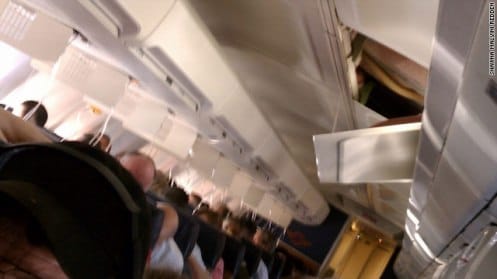…Put Your Mask on First and then…
How many times have you heard that briefing in preparation for past flights?
I gave a couple of local TV interviews here in the Phoenix area recently. I’m disappointed by the choice of words used in media reports about the recent Southwest Flt 812 incident: “Terrifying,” “loud bang,” “hole ripped in ceiling,” “thought I was going to die,” etc.
I told one reporter: “The pilots’ job was to respond appropriately to get the airplane down to an altitude where no one needed supplemental oxygen any more. The passengers’ job was to react each according to their emotional need for expression.”
I would expect someone riding in the cabin of a plane to be taken completely by surprise if a section of aircraft skin suddenly gave way, creating a sudden decompression. I can imagine the ensuing chaos with 100-mph plus winds and swirling debris exiting the hole in the short time it takes to equalize pressure with the outside air. No amount of emergency preflight briefings can prepare one for that experience–even if you paid attention! But that’s not my concern here.
My disappointment comes in the aftermath of an incident like this when the typical airline response is to provide vouchers for free travel some time in the future. That’s a nice gesture but the more appropriate thing to do would be to conduct even the briefest meeting with the passengers and crew facilitated by someone who knows about both trauma and aviation. Everyone gets to process his or her reactions in order to process the traumatic nature of the event. Passengers could hear the pilots’ and flight attendants’ personal reactions to the event and hear firsthand how their training allowed them to handle the emergency and bring it to a safe and successful close.
How Fear of Flying Gets Started
That’s the problem following an incident like this: people leave without dealing with their emotions in a timely manner, which is the human way of bringing closure to an event. For certain, some of the passengers are dealing with posttraumatic event thoughts about “what could have happened” that will last for years, if not forever. It does little good to have a voucher for free travel if your fear keeps you from using it. And a single traumatic event is all it takes to change brain chemistry. A better way would have been to get prompt, firsthand information about what happened, what the crew did to alleviate the threat of harm, and celebrate their sense of shared experience.
No matter the source of your fear of flying, www.fearlessflight.com is a place to release you from that fear as you can see in the video of a Phoenix anchorwoman’s fear of flying story recently published to YouTube.
Happy Landings,
Capt Ron





Thanks for your article. I, too, was quite bothered by the way the media chose to handle this situation. It seems like any time something like this happens I have to completely start over in my process of conquering my fear…after looking into cabin pressure and how it all works, I quickly realized that this wasn’t nearly as terrifying as the media made it out to be…
People ask me about my fears as a pilot. I distinguish between fear and startle response. Make no mistake it would be very startling to be in the cabin during the Southwest depressurization. It was also a surprise to the pilots–as I happen to know the Captain. But for the pilots, the moment of startle passes quickly as they assess the situation and take the proper action. As I said in the post, my biggest disappointment is that the passengers were likely not properly debriefed because the issue of whether they were traumatized or not is usually resolved by asking the passengers who are least capable of self-assessing under the circumstances.
Thanks for your insight to the Southwest incident. Whenever I hear these stories on the news, I try to relay to my 11yr old and 12yr old that flying is safe, no one was hurt and the pilot and crew know what they’re doing. It seems too often the media takes these type stories and instill fear, as opposed to giving accolades to keeping everyone safe.
My little brother has worked in the media for 30 years. I recall him telling me about prioritizing news events occurring simultaneously with consideration given to deaths, injuries, sentiment, etc. I honor the media’s role. It’s just that we have to discipline ourselves to be discerning. Kudos to you for reinforcing a sense of safety to your children. I’m always impressed when I work with fearful flyers who are tacking their fears so as not to pass them on to their children. Capt Ron
just read the article. this will be my first time flying. my grandmother told me about the time when why flew into a storm and the plane dropped some feet. so i hope things go well. i love the ground, the ground is my friend
If you grandmother was like mine, she had the best intentions but probably not the experience to go with them. Consequently, she was likely anxious–or at least startled–causing that memory to be burned into her limbic system. And it was so memorable that she told it over and over until it became part of her identity in the family. And as someone who looked up to her, you likely took her story and attached your own significance to it. That’s how fear of flying gets passed generationally–sadly. If you would like to discuss this more, got to https://fearlessflight.com/product-tour/personal-coaching/ and send me a message.
Capt Ron